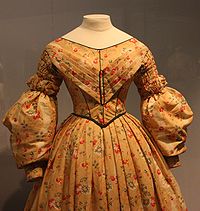Piping (sewing)


In
bias. It may be made from either self-fabric (the same fabric as the object to be ornamented) or contrasting fabric, or of leather.[1]
Today, piping is common on upholstery, bags, and decorative pillows, but it is also used on clothing. Piped pocket openings, garment edges, and seams are characteristic of Western wear.[2]
Ecclesiastical use
Piping is used extensively on the
Anglican
churches. Coloured piping is often used on black cassocks to indicate rank.
In the Roman Catholic church, cassock piping is: black for priests; purple for
cardinals.[3]
In the Anglican church, piping is not used universally, many clerics preferring a plain cassock of solid colour. The most common cassock piping in the Anglican church is scarlet red piping for cathedral deans and canons, and for archdeacons; additionally, bishops may wear black cassocks with amaranth red (usually called purple) piping.
References
- ^ Khalje, Susan (August–September 2005). "Create Ripple-Free Piping". Threads. Vol. 120. Taunton Press. pp. 40–45. Retrieved 14 March 2020.
- ISBN 0-8109-0615-5.
- ^ "Instruction on the Dress, Titles and Coats-of-Arms of Cardinals, Bishops and Lesser Prelates, 28 March 1969". Fiu.edu. Retrieved 25 August 2014.
